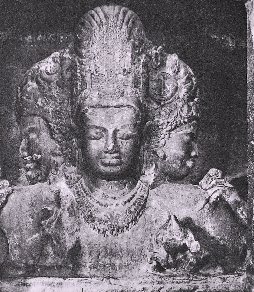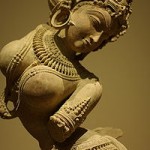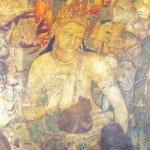
“The theory of ancient Indian art at its greatest – and the greatest gives its character to the rest and throws on it something of its stamp and influence – is of another kind. Its highest business is to disclose something of the Self, the Infinite, the Divine to the regard of the soul, the Self through its expressions, the Infinite through its living finite symbols, the Divine through his powers. Or the Godheads are to be revealed, luminously interpreted or in some way suggested to the soul’s understanding or to its devotion or at the very least to a spiritually or religiously aesthetic emotion. When this hieratic art comes down from these altitudes to the intermediate worlds behind ours, to the lesser godheads or genii, it still carries into them some power or some hint from above. And when it comes quite down to the material world and the life of man and the things of external Nature, it does not altogether get rid of the greater vision, the hieratic stamp, the spiritual seeing, and in most good work – except in moments of relaxation and a humorous or vivid play with the obvious – there is always something more in which the seeing presentation of life floats as in an immaterial atmosphere. Life is seen in the self or in some suggestion of the infinite or of something beyond or there is at least a touch and influence of these which helps to shape the presentation. It is not that all Indian work realises this ideal; there is plenty no doubt that falls short, is lowered, ineffective or even debased, but it is the best and the most characteristic influence and execution which gives its tone to an art and by which we must judge. Indian art in fact is identical in its spiritual aim and principle with the rest of Indian culture.”

When was the last time, you actually had an experience that would translate itself into the thoughts expressed above? Although what Sri Aurobindo says is irrefutable, on the other hand, there is a desperate lack of vision on the part of the beholder, which is perhaps one of the fundamental reasons why Indian Art has made so little an impact on the general populace. We are invariably in a hurry to brush past these concrete manifestations of subtle planes, not just physically but mentally too. A cursory glance with a mind that is far too occupied with thoughts that belong to another time, the past or the future, is possibly the worst insult to the artist and yet, each art work would have its desired viewer once in a very blue moon. However, there is never any point behind coercing the mental and almost certainly disastrous to impose on the psychic, a certain method or trained system of catching the essence, for these things belong to a realm that can only be experienced deep within – no amount of knowledge imparted, clues, tips, insights will reveal to the beholder anything more than what he himself is ready to perceive. And thus, the magic more often than not, remains an enigma or a topic for arm chair intellectualism.
But then what? Should one entirely give up and wait for the fateful day of sudden illumination or is it possible that a mere idea at first of a ‘something’ that is there and yet hidden from our sight, can penetrate into our thought process with such intensity that it becomes imperative for us to labour after the revelation? One may for instance be deeply convinced of the existence of God but not having come face to face with Him doesn’t always put us off our own beliefs. Likewise, there is a tiny possibility that once having been introduced to the notion of a spirit of art, a viewer may indeed yearn enough and make art the means of his own spiritual realizations. Anything can become the means – even stone or paint. A repeated visit to the Ajanta caves can in a moment of truth open the eyes of the viewer and allow him to enter into its tapestry of living moments; the key to the inner recesses however, lies in persistent aspiration. Moreover, instead of bringing the artist down to the viewer’s level of understanding, an attempt has to be made to link one’s thought with the artist, to try and see where he came from, where he delivered from.

“A seeing in the self accordingly becomes the characteristic method of the Indian artist and it is directly enjoined on him by the canon. He has to see first in his spiritual being the truth of the thing he must express and to create its form in his intuitive mind; he is not bound to look out first on outward life and Nature for his model, his authority, his rule, his teacher or his fountain of suggestions. Why should he when it is something quite inward he has to bring out into expression? It is not an idea in the intellect, a mental imagination, an outward emotion on which he has to depend for his stimulants, but an idea, image, emotion of the spirit, and the mental equivalents are subordinate things for help in the transmission and give only a part of the colouring and the shape. A material form, colour, line and design are his physical means of the expression, but in using them he is not bound to an imitation of Nature, but has to make the form and all else significant of his vision, and if that can only be done or can best be done by some modification, some pose, some touch or symbolic variation which is not found in physical Nature, he is at perfect liberty to use it, since truth to his vision, the unity of the thing he is seeing and expressing is only his business. The line, colour and the rest are not his first, but his last preoccupation, because they have to carry on them a world of things which have already taken spiritual form in his mind. He has not for instance to re-create for us the human face and body of the Buddha or some one passion or incident of his life, but to reveal the calm of Nirvana through a figure of the Buddha, and every detail and accessory must be turned into a means or an aid of his purpose. And even when it is some human passion or incident he has to portray, it is not usually that alone, but also or more something else in the soul to which it points or from which it starts or some power behind the action that has to enter into the spirit of his design and is often really the main thing. And through the eye that looks on his work he has to appeal not merely to an excitement of the outward soul, but to the inner self, antaratman. One may well say that beyond the ordinary cultivation of the aesthetic instinct necessary to all artistic appreciation there is a spiritual insight or culture needed if we are to enter into the whole meaning of Indian artistic creation, otherwise we get only at the surface external things or at the most at things only just below the surface. It is an intuitive and spiritual art and must be seen with the intuitive and spiritual eye.
This is the distinctive character of Indian art and to ignore it is to fall into total incomprehension or into much misunderstanding. Indian architecture, painting, sculpture are not only intimately one in inspiration with the central things in Indian philosophy, religion, Yoga, culture, but a specially intense expression of their significance.”
(Quotes by Sri Aurobindo from The Foundation of Indian Culture)





